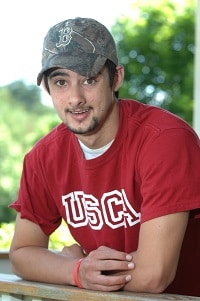Speech Therapy Patient Story
Finding His Voice
 Eighteen-year-old Colin Rooney of Upton was ten minutes away from starting his college education at the University of South Carolina, when his life changed dramatically. His car was struck by an eighteen-wheeler causing Colin to suffer a traumatic brain injury, along with fractures to his femur, pelvis and skull. Now nine months later - after surgery, rehabilitation and a lot of hard work, Colin started working with Milford Regional speech language pathologist April Izzi, MSEd, CCC-SLP, to find his voice again.
Eighteen-year-old Colin Rooney of Upton was ten minutes away from starting his college education at the University of South Carolina, when his life changed dramatically. His car was struck by an eighteen-wheeler causing Colin to suffer a traumatic brain injury, along with fractures to his femur, pelvis and skull. Now nine months later - after surgery, rehabilitation and a lot of hard work, Colin started working with Milford Regional speech language pathologist April Izzi, MSEd, CCC-SLP, to find his voice again.
“We have ways of making you talk,” April says with a twinkle in her eye, and no, she’s not referring to employing archaic torture devices. Instead April, along with a team of Milford Regional speech language pathologists, are excited about providing patients with a cutting edge technology called VitalStim®.
VitalStim® is a novel therapy that is used to help patients who have trouble swallowing or speaking, a problem common in those who have suffered a stroke or traumatic brain injury, like Colin. This noninvasive treatment works by using a low level electrical current to stimulate the throat muscles. Electrodes are placed on the neck and the current causes the muscles to contract and become stronger. It is especially effective when combined with swallowing or speech exercises so that both the outside and inside throat muscles are working together. It works by making the muscles coordinate better and eventually remaps the brain.
Colin jokingly calls it his electrocution therapy. “It gave me my voice back,” he says with a grin. “It’s not fully back, but basically it is.”
Colin’s mother Colette Rooney concurs. “You never realize how important the everyday things like your voice are,” she marvels. “If your voice sounds funny, people automatically assume something is wrong with you. We knew Colin’s voice was in there, we just needed to get it out. The VitalStim® therapy was instrumental in getting our son’s voice back.”
The number of VitalStim® treatments required depends upon the patient and situation, but typically ranges from three to twelve sessions. Most commonly sessions run twice a week and can last from several weeks to several months. Each session is about an hour long. The speech language pathologists at Milford have seen amazing results. “Before VitalStim®, we would teach patients certain exercises and ask them to practice them at home,” speech language pathologist Kristin Anderson, MS, CCC-SLP, recalls. “It was a longer, tougher process. Now we are changing peoples’ lives and their family’s lives.”
Colin, who went to the Milford rehabilitation site for speech therapy two to three days a week, noticed a difference in his ability to swallow right away. The improvement in his voice came later. April worked with Colin to slowly increase the time he had the electrodes on, starting with 20 minutes until reaching the full 45 minutes of each session. He describes the electrodes as feeling like pins and needles, and according to Colette, he was able to tolerate the highest level from the beginning.
When Colette described Colin’s treatment to his neurologist, she was surprised to learn that VitalStim® is not available everywhere - including the rehabilitation hospital where Colin was originally seen. Seeing the progress Colin has made, his neurologist is working on bringing the therapy into the rehabilitative hospital.
In order to be able to offer VitalStim®, speech language pathologists must undergo a vigorous certification process, including intensive classes, labs, testing and actual practical experience. “We’re lucky,” Kristin says. “We have three speech language pathologists certified in VitalStim®. We can provide it in the hospital, at home or in our Milford clinic. And the need continues to grow as baby boomers age and the number of stroke patients continues to increase.”
April agrees. “VitalStim® is the best thing to come down the pike for speech therapy,” she points out. “We’ve seen incredible results.”
Colin’s mother could not agree more. “It’s such a progressive therapy; it’s given us our son’s voice back,” Colette says emphatically, “We’ve been so lucky with the care we’ve received. Colin always looked forward to sessions because they make them fun and exciting.”
The convenience of the Milford site has also freed up Colin’s schedule. Colette is relieved to avoid the long drive into Boston for treatment and is moving Colin’s physical and occupational therapy to the Milford rehab site.
Colin is getting back into the swing of things by taking an accelerated college course in math this summer. He has most definitely found his voice. “There’s a lot of times I want to just relax but can’t,” he says resolutely.
His comment brings a smile to Colette’s face. “It’s been a lot of hard work,” she agrees, but adds, “We’ve had a lot of angels help us along the way.”
For information on speech therapy or VitalStim® therapy in particular, call Rehabilitation & Sports Medicine’s Milford location at 508-422-2388, Northbridge location at 508-234-8792, or Franklin location at 508-528-2748.
Or go to Milford Regional's Speech Therapy Program